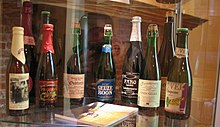Lambic
| Lambic | |
|---|---|

Bottled lambic beers
|
|
| Country of origin | Belgium |
| Yeast type | Spontaneous fermentation |
| Alcohol by volume | 2–8% |
| Color (SRM) | Yellow or pale to deep gold or dark red |
| Malt percentage | 66% |
Lambic is a type of beer brewed in the Pajottenland region of Belgium southwest of Brussels and in Brussels itself at the Cantillon Brewery. Lambic beers include gueuze and kriek lambic.
Unlike most beers, which are fermented with carefully cultivated strains of brewer's yeast, lambic is fermented spontaneously by being exposed to wild yeasts and bacteria native to the Zenne valley in which Brussels lies. This process gives the beer its distinctive flavour: dry, , and cidery, usually with a sour aftertaste.
The word lambic is probably derived from Lembeek, a municipality near Halle, Belgium.
The beer is generally brewed from a grist containing approximately 60–70% barley malt and 30–40% unmalted wheat. The wort is cooled overnight in a shallow, flat metal pan called a coolship where it is left exposed to the open air so microorganisms may inoculate the wort. While this cooling method of open air exposure is a critical feature of the style, the key yeasts and bacteria that perform the fermentation reside within the breweries' timber fermenting vessels. Over eighty microorganisms have been identified in lambic beer, the most significant being Saccharomyces cerevisiae, Saccharomyces pastorianus and Brettanomyces bruxellensis. The process is generally only possible between October and May as in the summer months there are too many unfavourable organisms in the air that could spoil the beer.
Since at least the 11th century, and probably earlier, hops have been used in beer for their natural preservative qualities as well as for the pleasant bitterness, flavour, and aroma they impart. Since the method of inoculation and long fermentation time of lambic beers increases the risk of spoilage, lambic brewers use large amounts of hops for their antibacterial properties. Lambic in the early 19th century was a highly hopped beer, using 8–9 g/l of the locally grown Aalst or Poperinge varieties. Modern lambic brewers, however, try to avoid making the beer extremely hop forward and utilise aged, dry hops which have lost much of their bitterness, aroma and flavour. Consequently, lambics often have a strong, cheese-like, "old hop" aroma, in contrast to the resiny, herbal, earthy hop bitterness found in other styles. The favourite hop used for lambic in the nineteenth century was a variety called Coigneau which was cultivated in the Aalst-Asse area in Belgium.
...
Wikipedia
